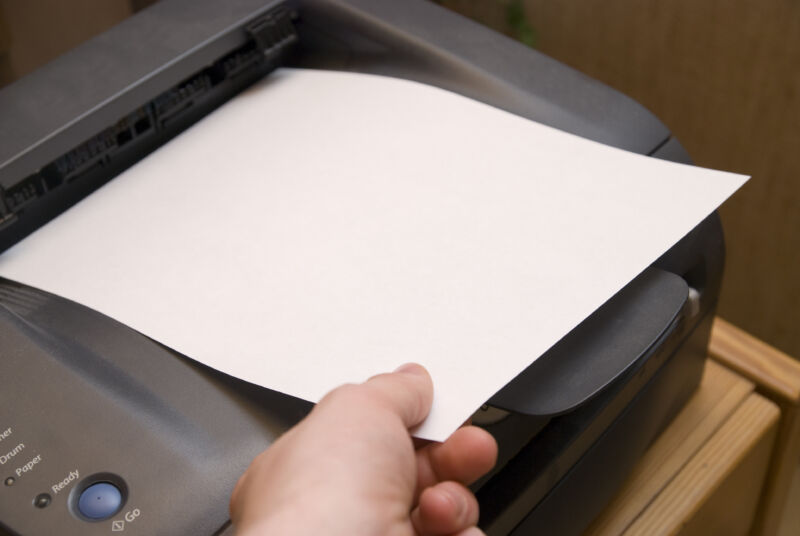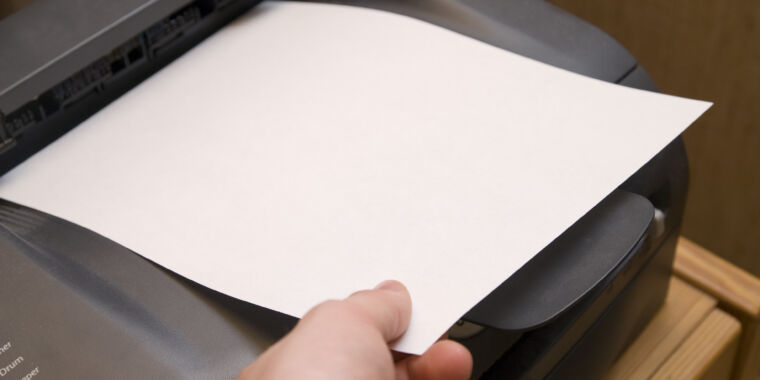
Epson printers have had a nasty little issue for years. Some models will abruptly brick, even if they seem to be working fine, because the ink pads are supposedly too saturated. Epson has endured bad publicity the past few weeks as users, websites, and right-to-repair activists condemned the company for designing its printers to eventually stop functioning, highlighting just how big of a problem printers continue to be in the fight for the right to repair.
According to the Fight to Repair newsletter, Epson printers—including the L360, L130, L220, L310, L365, and potentially others—may suddenly display a message saying that they have reached the end of their service life and then stop printing. Epson told The Verge this week that this is because saturated ink pads could leak ink throughout the devices.
Until this week, Epson’s support page about the message said:
At some point, the product will reach a condition where either satisfactory print quality cannot be maintained or components have reached the end of their usable life. Epson is committed to ensuring the proper operation of all our devices to minimize the risks of property damage or personal injury during the life span of the product. The printers are designed to stop operating at the point where further use without replacing the ink pads could create risks of property damage from ink spills or safety issues related to excess ink contacting an electrical component.
The issue has been ongoing for years, and there are multiple videos instructing people how to fix the ink pads. In late July, however, the issue hit Twitter, as spotted by Gizmodo this week, putting fresh attention on Epson’s printer bricking and leading to allegations of planned obsolescence.
Epson is not the only company to break its own seemingly functional printers over ink issues. Another recent example is HP, which in 2020 killed ink cartridges that weren’t part of its Instant Ink subscription program. The company still continues the practice. HP also has a history of trying to use DRM to block users from using non-HP ink cartridges in its printers.
Canon doesn’t want people to use non-proprietary ink so badly that it inadvertently made its own ink unusable earlier this year.
Printer companies have such a penchant for controlling how you use their products that the issue has gone all the way to the Supreme Court. In 2017, Lexmark battled to stop Impression Products from circumnavigating DRM to refill and resell its ink cartridges—and lost.
Indeed, printers have a checkered reputation when it comes to this sort of thing, and the situation doesn’t seem to be getting better. Just look at how Epson handled its recent bad PR.
This week, as noticed by The Verge, the company changed the support page about its end-of-service message, putting its one-time Maintenance Reset Utility, which enables the continued use of the printer temporarily, closer to the top of the page. Before this week, the support page was quick to claim that “most consumers who are out of warranty elect to replace a lower-cost printer when they receive an end of life service message.”
But the page now points to Epson’s ink pad replacement service and more prominently showcases the company’s recycling program. Finally, the page eliminated the previously quoted statement that tries to convince people that it’s perfectly normal to get rid of their would-be functioning printer and give Epson more money upon seeing the end-of-service message.
These are minuscule steps, though. Epson still doesn’t readily offer repair manuals, tools, or parts. And it still says that only Epson or one of its partners can address the ink pads, implying that you or your favorite local repair shop cannot. This ignores the video tutorials showing that people have figured out how to address the ink pad issues on their own.
Without some extra push, printer companies will continue to employ invasive methods for controlling how their products are used. Some believe that push could come from the government.
“It wouldn’t surprise me to see some pushback along the lines of the FTC’s intervention in the Revolv bricking incident a few years back,” Aaron Perzanowski, a professor at the University of Michigan School of Law and author of The Right to Repair: Reclaiming the Things We Own book, told the Fight to Repair newsletter.
In 2016, the FTC wrote a letter (PDF) to Google Nest detailing concerns that the company’s bricking of Revolv Smart Home Hub devices would cause “unjustified, substantial consumer injury that consumers themselves could not reasonably avoid.” The agency elected not to recommend enforcement action, partially because Nest gave refunds.








